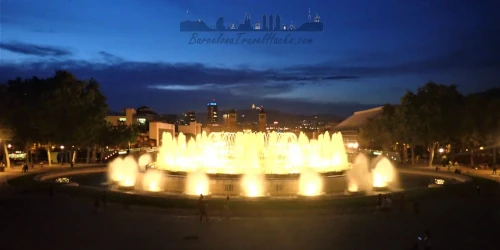 METRO
METRO
2025 guide for visiting Montjuïc mountain in Barcelona
Maps, transport & guides for visiting the 19 attractions in Montjuïc mountain, from cable cars, castle, botanical gardens, art museums & Olympic stadiums
About Barcelona's Montjuïc Mountain
Montjuïc Hill is the small mountain behind the industrial Port of Barcelona with a fortress on top. It is a great place for easy city walks in nature whilst enjoying the multiple viewpoints of Barcelona city. Montjuïc has a variety of museums, sports complexes, historic monuments and landscaped Mediterranean gardens.
Montjuïc History
The development and history of Montjuïc has often been triggered by global events that Barcelona has hosted.
Medieval Montjuïc and Fortification
Montjuïc, pronounced "mon-ju-ic (the T is silent, accent the i), is a literal amalgamation of Mont (mountain) and Jueu (jewish). Montjuïc, the Jewish Mountain was, in medieval times, farmland and served as a prominent Jewish cemetery for Barcelona's large Jewish population.
Montjuïc, rising 173m above sea level, is a hill with clear views over the Llobregat delta and Barcelona city as well as the important port of Barcelona. This made Montjuïc an obvious location for fortification. Montjuïc has had a watchtower and signal beacon since at least as far back as 1073. Throughout history, Montjuïc Castle Fortress has grown in size with the current version dating from 1799.
In 1883 the Montjuïc was chosen to Become Barcelona's main cemetery due to the Expansion of Barcelona during the industrial revolution. Montjuïc Cemetery is still in use today and houses the Historic Funeral Carriages Museum.
Montjuïc and the 1888 Barcelona Universal Exposition
The 1888 Barcelona Universal Exposition was Spain's first International World Fair and ran from 8 April to 9 December 1888. The main legacy of the 1888 World Fair is Ciutadella Park, with the effect on Montjuïc being the expansion of quarrying to extract the sandstone that most of Barcelona's grand buildings are constructed from. Montjuïc was said to have up to 28 quarries, two of which can be visited today in the form of the Greek Theatre and the Historic Botanical Gardens.
Montjuïc and the 1929 World Exhibition
The second World Fair to be held in Barcelona, the first one being in 1888. It took place from 20 May 1929 to 15 January 1930 and was predominantly held in newly constructed venues around Montjuïc Mountain.
Using Stone quarried from Montjuïc, the Palau Nacional was constructed, This is the prominent building that you can see from the Magic Fountains and today houses the MNAC (Museo Nacional de Art Catalan). The pavilions of Fira 1 that surround the magic fountains are also part of the exhibition spaces constructed for the 1929 world fair.
Above and around the Palau Nacional, ornate Mediterranean Gardens (Jardins de Montjuïc), were built as walking spaces for the visitors. A quarry was repurposed into Montjuïc Greek Theatre and rose garden.
On the lower slopes of Montjuïc, a replica walled village was constructed called Poble Espanyol to illustrate some important Spanish architecture and the different styles used in the different autonomous regions of Spain. It houses craft shops, workshops and many varied restaurants and cafes.
The Montjuïc Funicular was opened in 1928 to provide access to the venues for the 1929 world fair.
The Estadi Lluís Companys was also constructed for the 1929 world fair with the idea of it being repurposed for the 1936 Summer Olympics, the bid actually being granted to Berlin, due to the Spanish civil War.
1992 Barcelona Olympic Games
The Lluís Companys Stadium is rebuilt and enlarged to be the main track and field arena for the Olympics as well as the additional constructions of the Palau Sant Jordi indoor arena for Gymnastics, volleyball, handball, etc. The Picornell Olympic swimming pools and the Torre Telefonica Communications Tower to transmit the Games on television.
Montjuïc also gained a diving swimming pool (Piscina de Salto) for the 1992 Olympics, located near to the Montjuïc Funicular.
Happy Exploring!
The 1929 World Exposition & Museums
 METRO
METRO
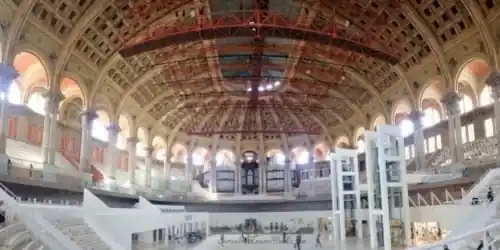 METRO
METRO
Museu Nacional d’Art de Catalunya MNAC – Palau Nacional Barcelona
Visit MNAC in Montjuïc’s Palau Nacional. Explore Romanesque, Gothic, Renaissance & Catalan Modern Art. Tickets, discounts & accessibility info
Read more >
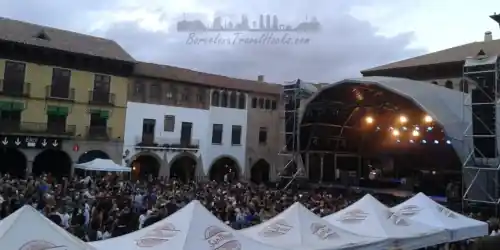 METRO
METRO
Poble Espanyol Barcelona – Culture, Events & Flamenco
Explore Spanish architecture, artisan shops, concerts & flamenco shows at Poble Espanyol in Montjuïc. Tickets, hours & event info included
Read more >
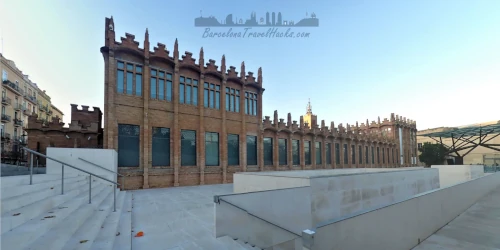 METRO
METRO
CaixaForum Barcelona – Art Exhibitions & Cultural Hub
Explore CaixaForum Barcelona: a Modernist museum with art exhibitions, cultural events & historic architecture. Tickets, hours & access info
Read more >
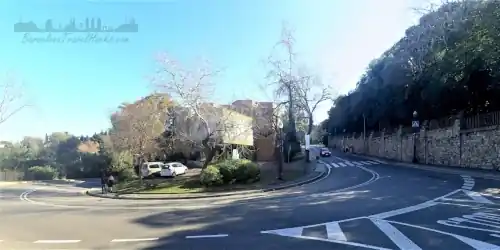 METRO
METRO
Barcelona Ethnological Museum in Montjuïc – Cultural Gems
Explore 70,000+ artifacts at Museu Etnològic Montjuïc. Discover Catalan heritage, global cultures, and enjoy free museum entry on select days
Read more >
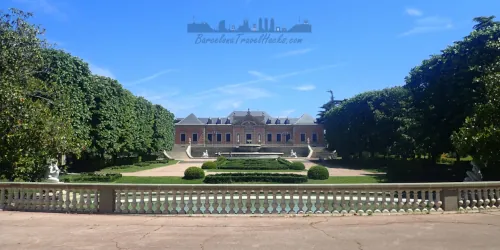 METRO
METRO
Joan Maragall Gardens & Albéniz Palace in Montjuïc
Elegant French-style gardens around a neoclassical royal pavilion. Weekend access, classical statues, and peaceful lawns in Montjuïc, Barcelona
Read more >
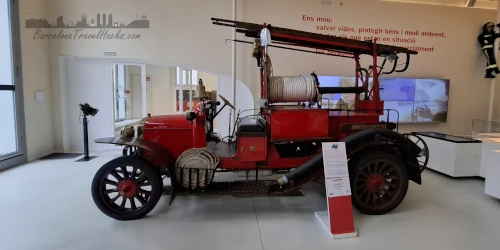 METRO
METRO
Fire Brigade Museum | Espai Bombers: Parc de la Prevenció
Explore Espai Bombers, Barcelona’s historic fire station museum featuring vintage firefighting vehicles and stories of famous fires. A must-see Montjuïc museum
Read more >
Cable Cars, Castles & Gardens
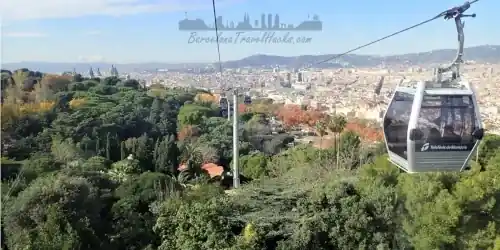 METRO
METRO
Montjuïc Cable Car & TMB Funicular – Reach the Castle with Views
Ride the Montjuïc Funicular from Paral·lel Metro, then soar via cable car to Montjuïc Castle. Scenic views, ticket info, and accessibility tips included
Read more >
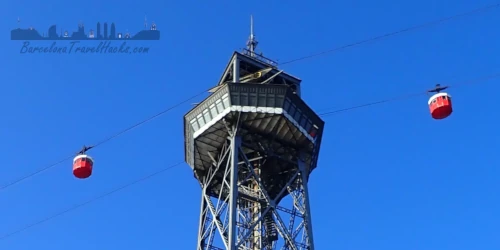 METRO
METRO
Barcelona Port Cable Car – Tickets, Hours & Views from Transbordador Aeri
Ride the Transbordador Aeri del Port cable car 1.3 km over Port Vell from Barceloneta to Montjuïc. Get ticket info, opening hours, and travel tips
Read more >
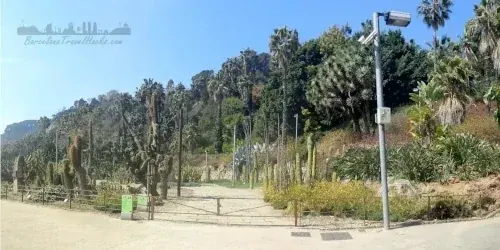 METRO
METRO
Montjuïc Cactus Garden | Succulent Park with Sea Views Barcelona
Discover Montjuïc’s hidden cactus garden near Miramar. Explore exotic succulents, panoramic city views, and one of Europe’s largest drought-tolerant collections
Read more >
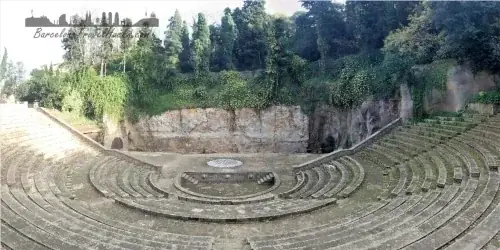 METRO
METRO
Greek Theatre & Rose Garden | Montjuïc Open Air Venue
Explore Montjuïc’s Greek Theatre & Rose Garden. Summer shows, yoga classes, and Grec Festival performances in a scenic open air amphitheatre
Read more >
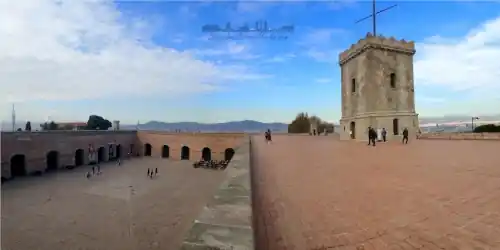 METRO+BUS
METRO+BUS
Montjuïc Castle Barcelona – Fortress, Museum & City Viewpoint
Explore Montjuïc Castle: a bastioned fortress, military museum, Civil War prison, and panoramic viewpoint. Former Spanish Army base, now open to the public
Read more >
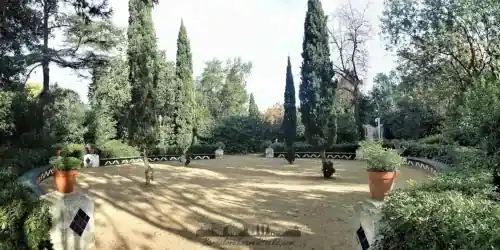 METRO
METRO
Montjuïc Gardens – Laribal, Joan Brossa & Verdaguer Viewpoints
Explore Montjuïc’s scenic gardens: Laribal, Joan Brossa & Verdaguer. Historic green spaces with city views, fountains & walking routes
Read more >
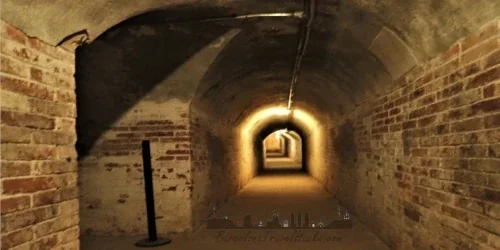 METRO
METRO
Refugi 307: Underground Civil War Shelter in Poble Sec, Barcelona
Explore Refugi 307, a hidden underground air raid shelter from the Spanish Civil War in Poble Sec, Barcelona. Guided tours every Sunday. Book tickets via MUHBA
Read more >
Montjuïc Olympic and Botanical
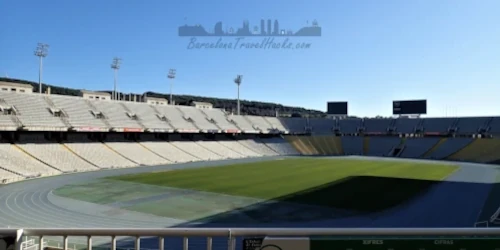 METRO+BUS
METRO+BUS
Estadi Olímpic Lluís Companys – FC Barcelona Stadium
Visit FC Barcelona’s temporary stadium in Montjuïc. Olympic history, concerts, tours, and match-day access at Estadi Olímpic Lluís Companys
Read more >
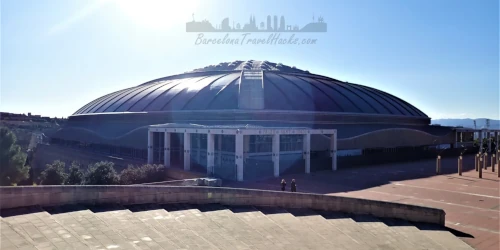 METRO
METRO
Palau Sant Jordi & Montjuïc Olympic Park Concert Venue
Explore Palau Sant Jordi in Montjuïc Olympic Park. 1992 Olympic arena, concerts, and the iconic Telefonica needle tower. Access, events & architecture
Read more >
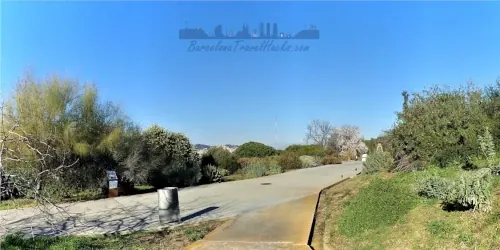 METRO
METRO
Barcelona Botanical Gardens | Montjuïc Nature & Bonsai
Explore Barcelona’s Montjuïc Botanical Gardens. Discover bonsai trees, Mediterranean plants, cactus trails, and spring flowers with city views
Read more >
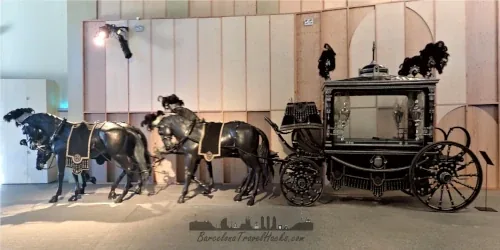 METRO
METRO
Funeral Carriages Museum – Montjuïc Cemetery Barcelona
Explore historic funeral carriages in Montjuïc Cemetery. Free museum, notable burials, and walking routes through Barcelona’s most serene cemetery
Read more >
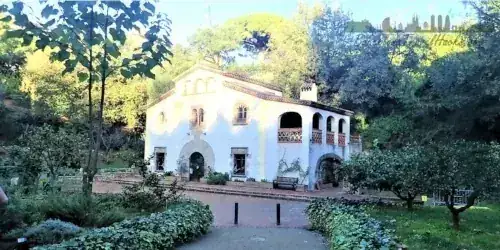 METRO
METRO
Montjuïc Historic Botanic Garden | Sensorial Garden Barcelona
Explore Barcelona’s first botanical garden in Montjuïc. A sensorial garden in a former quarry with rare plants, free entry, and peaceful nature walks
Read more >
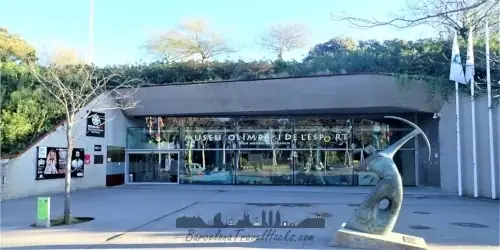 METRO
METRO
Olympic & Sports Museum | Montjuïc 1992 Olympic Exhibits
Explore Barcelona’s Olympic & Sports Museum on Montjuïc. Interactive exhibits, 1992 Olympic history, and family-friendly fun. Tickets, hours & directions
Read more >
Map of Barcelona's Montjuïc Mountain
Events in Barcelona's Montjuïc Mountain
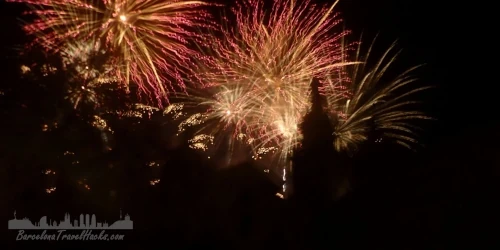 METRO
METRO
New Years Eve Plaça España laser show and fireworks display
An honest guide to viewing the Barcelona New years fireworks display. Where to view the fireworks from, timings, traditions and where to go after
Read more >
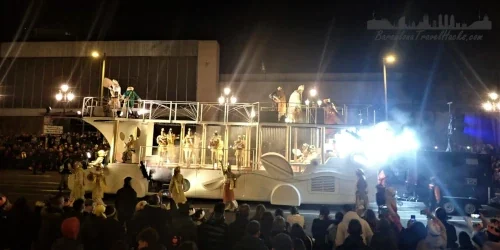 METRO
METRO
Barcelona Three Kings Parade | Reyes Magos 2026 Route & Tips
Celebrate Reyes Magos in Barcelona with floats, sweets, and music. Find the best viewing spots, route map, and parade times for January 5th 2026
Read more >
Tickets & Tours for Barcelona's Montjuïc Mountain
Getting to Barcelona's Montjuïc Mountain
Montjuïc is linked to Barceloneta from the Mirador de Miramar (sea viewpoint) via the Miramar Mirador red cable car that goes over the port of Barcelona.
Montjuïc is also served by the Montjuïc funicular from metro Parallel on the green (L3) and purple (L2) lines. The Montjuïc funicular upper stations is next to the Olympic diving pools. From here there is the Montjuïc Gondola cable car to Montjuïc castle.
MNAC, Montjuïc Magic fountains, Poble Espanyol, Montjuïc gardens and Caixa Forum are within easy walking distance of metro Plaça España on the red (L1) and green (L3) lines. Plus Plaça España is the terminus for the FGC Anoia-Llobregat lines.
The 150 bus from Plaça España runs a route which passes via most of the attractions in Montjuïc.
The most popular excursion to Montjuïc is to take the Funicular then change on to the teleferico gondola cable car to the Fortress.
Use a T-Casual or Hola-Barcelona travel card which covers Metro, Montjuïc funicular and bus services but not the two cable cars.
Parking in Montjuïc
- Parking Near Montjuïc Castle 41.363477, 2.158453
- Parking Next to MNAC 41.367890, 2.151912
Where to Eat in Barcelona's Montjuïc Mountain
Montjuïc is mostly parks and gardens with very few restaurants but there are sandwich kiosks where you can get a beer and a hot or cold sandwich.
Montjuïc restaurants for a full meal
- El Xalet de Montjuïc: Sweeping city views from the luxury outside dining garden. Mediterranean dishes with prices of €15 to €30 so expect to pay €80 to €120 per person. Reservation only.
Avinguda Miramar 31, 08038 Barcelona 41.369130, 2.164168 - Terrassa Martínez: Terrace restaurant with views over Barcelona port. Dishes are based around rice and meat and include paella, tapas grilled meat and fish. Dishes are priced from €5 to €30 so expect to pay €50 to €80 per person.
Carraterra de Miramar 38 (Plaça de l'Armada) 08038 Barcelona 41.3696750, 2.172447
Montjuïc Snack Kiosks
Expect to pay €2 euros for a cold drink, €3 for a cold beer and €5 for a sandwich.
- Bar Marcelino: views of Barcelona city from shaded location. kiosk has tables, chairs and toilet facilities.
Carrer de Margarit 85, 08004 Barcelona 41.369344, 2.161946 - Salts Terrassa Bar: views of Barcelona city from terrace bar inside the Olympic diving pools. kiosk has tables, chairs and toilet facilities.
Avinguda Miramar 31, 08038 Barcelona 41.369159, 2.165454 - Bar Mirador de l'Alcalde: views of Barcelona city hill top viewpoint next to fountains.
Plaça de la Sardana 717, 08038 Barcelona 41.3675849, 2.169366 - Cafè bar El Cims: bar in a shaded area of Montjuïc next to childrens play area.
Plaça de la Sardana 717, 08038 Barcelona 41.3662215, 2.167092 - La Caseta del Migdia: bar behind Montjuïc castle in a pine forest. kiosk has tables, chairs and toilet facilities. This bar often has Live music and is my personal favourite.
Plaça de la Sardana 717, 08038 Barcelona 41.359593, 2.160827 - Bar Les Cascades: bar in front of MNAC next to the fountains. kiosk has tables, chairs and toilet facilities.
Passeig de Jean Forestier s/n, 08038 Barcelona 41.369414, 2.152426 - Bar Palau Sant Jordi: bar in front of Palau Sant Jordi. Cold drinks and sandwiches.
Avenida de l'Estadi 40, 08038 Barcelona 41.366076, 2.152064
Other places to Eat in Montjuïc
The Following Attractions have canteen style restaurants inside:
- Montjuïc National Palace MNAC
- Joan Miró Foundation
- Montjuïc Castle
- CaixaForum Barcelona
- Poble Espanyol (plus restaurants for three course meals)
Documents for Barcelona's Montjuïc Mountain
Click on any of the PDF thumbnails to view in full screen and download
Weather for Barcelona's Montjuïc Mountain
What to take with you for Barcelona's Montjuïc Mountain
I recommend comfortable shoes and a small water bottle that can be topped up in the drinking water fountains in the gardens.
Wikiloc Trail for Barcelona's Montjuïc Mountain
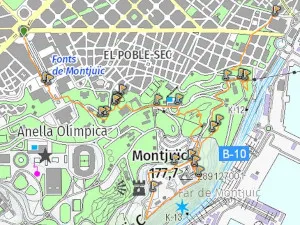
BCN01 - Montjuic castle and gardens
A city walk in the Gardens of Montjuic passing via Venetian towers, Magic fountains, Museum of Catalan Art (MNAC), Greek theatre, Montjuic Castle ans Miramar cable car.
Transport: Metro Fare: T-Casual Zone 1 Distance: 7.37 Difficulty: Easy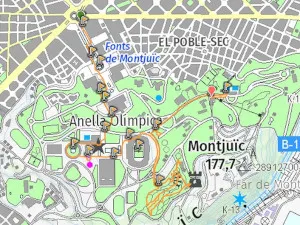
BCN08 - Olympic Montjuic
City walk in barcelona via Olimpic Montjuic. Museum of Catalan Art (MNAC), Palau Jordi, Olimpic Stadium, Botanical gardens, Olympic museum of sport and Olympic diving pools.
Transport: Metro Fare: T-Casual Zone 1 Distance: 7.07 Difficulty: EasyPlease sign in with Google to view the Wikiloc Route map.
Sign in with GoogleWhere to stay overnight in Barcelona's Montjuïc Mountain
How much does Barcelona's Montjuïc Mountain Visit Cost?
Montjuïc is Free to walk around in and explore the Gardens. The bellow attractions charge a fee to enter.